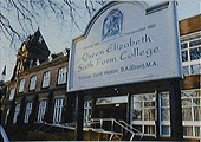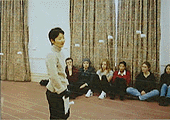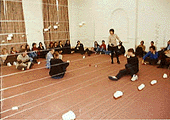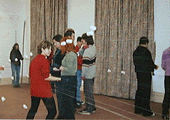 |  |  |
| HOME | KAZUE MIZUSHIMA | STRINGRAPHY | STUDIO EVE |
| WORKSHOP For Queen Elizabeth Sixth Form College in Darligton (UK) |
--- CONCEPT(Introduction)
--- CRITICS(interview article)
CONCEPT
1. Introduction 2. Let's try to make sound with Stringraphy.
How to make Stringraphy?
Bring ideas from students (divide them into several groups, a group emphasis on physical expression, a group emphasis on installation, a group emphasis on musical expression) 3. Development 4. Development 5. Complete the pieces
Run through the program
 |  |  |
|
Hello. My name is Kazue Mizushima. I am a musician and composer from Tokyo. My instrument is called the "Stringraphy". Stringraphy is a new word which I created from the English words "string" and "graph". The Stringraphy is an acoustic musical instrument which looks like string telephones. (Indicating Stringraphy sets) These are made of silk thread and paper cups. When I rub or pluck on a string, the vibration is amplified by the two paper cups attached to the string, making the sound audible. Let me demonstrate what the Stringraphy sounds like. (Demonstration 5 min.) I discovered that String Telephones can be used as acoustic musical instruments seven years ago. I was participating in a performing arts festival on a mountain side in northern Japan. The idea of the festival was to perform with the natural environment. When I stood in the forest, I thought that it would be wonderful if I could transform the forest into a giant harp by stretching hundreds of strings between the trees. I tried it, and this was the first time I played music with string telephones. At the time I was a composer of experimental music. I was interested in finding new devices for expressing my personal sense of music after having studied classical music composition for more than 10 years. I had tried many avant-garde things, like plucking the strings inside the piano, using the sound of water dropping and rubbing big metal trash cans with a super ball mallet. Using String Telephones was one of those ideas. I never imagined I would still be playing string telephones seven years later. But I am. I was encouraged to further develop the idea by people's reaction to my Stringraphy performances. I had been wondering how I could get bigger audiences for my music. It is quite difficult to get many people to come to experimental concerts. I found that the audience reacts differently when I make music with string telephones. Many types of people - children, adults, the elderly, musicians, dancers, school teachers, housewives, businessmen and so on, are interested in Stringraphy concerts. They show a frank curiosity first, and ask me how I can make such a variety of sounds with such a simple child*s toy. They are still fascinated by string telephone music even once they know how simple the system is. Then they become interested in playing the instrument by themselves. They enjoy playing the Stringraphy more than just listening to it. They say that they feel as if they had been taken back to their childhood and this gives them a serene feeling. It has been seven years since I first performed Stringraphy music. The music has been changed a lot over this time. My first Stringraphy performance in the forest was improvisation. I stretched about one hundred string telephones between the trees. I got the wonderful feeling that I was collaborating with natural sound; the wind, birds and the sounds of insects. After the first performance I realized that the Stringraphy had great possibilities for being installation art . The many strings create interesting geometric forms which stimulate our imagination. The Stringraphy is a spatial instrument as well as being a string instrument. By putting up the silk threads, we transform the performing space into a giant acoustic instrument. No two Stringraphy concerts can be the same, because the Stringraphy changes it's form according to the performing space. I have performed at many types of places during these seven years, including art museums, a traditional style Japanese house more than 300 years old, elementary school gymnasiums and hospitals. I have gotten into the habit of imagining what musical scale is the most appropriate for the space whenever I visit a new place. I also found that Stringraphy has possibilities in terms of dance. I tried many collaborative works with dancers for the first four years. I would like to show you a video tape of one of those pieces, titled " A geometry of big hand city" in 1993 . (VIDEO " A geometry of big hand city") Now let me show you a video tape of another collaborative work, this one with a Noh flute player in 1995. Noh is a Japanese traditional theater play with dance developed in 15th century. (VIDEO, "Kazue Mizushima & Yukihiro Issoh") After creating many experimental works, I reached the simple conclusion that the more I focus on the musical aspect, the more interesting the Stringraphy performance becomes. My movements look more persuasive when I move to express the music. The strings look more beautiful when I only put up the strings necessary for sounds. Three years ago I formed a Stringraphy Ensemble. When we have concerts now, three to eight performers play a wide musical repertory including original pieces, Gagaku, a form of Japanese traditional music, western classical music, popular music and contemporary music. Let me show you some examples from those concerts. (VIDEO, J-Pop, Etenraku, Ohsaka) The Stringraphy is a musical instrument which constantly evolves. Three months makes a big change. If I come back here three years from now the Stringraphy you see then will be totally different from what you see today. I noticed that the Stringraphy evokes artistic inspirations from the people in the audience who are not artists. I have been holding a series of workshops for adults since last January. They come once a week and study about Stringraphy. Each student has different background. One woman is 46 years old and works for public schools as a dietitian. There is also a 17-year-old high school girl. None of the students are musicians nor artists. I will never forget the first class I gave them one year ago. I taught them about the basic way of making sound. Then I told them about musical scores which are not notated by pitch and rhythm. We can also describe music with graphs and words and so on. I asked them to compose a short piece with their favorite notation and perform it. The result was wonderful. There were eight people in the class. Each person expressed very unique thoughts through the Stringraphy. The dietitian developed a dramatic idea about New Year*s Eve. She expressed the density of time changing from the 31st of December to the first of January. A 24-year-old man who doesn't want to tell us about his job expressed a picture of Mondrian. He created a short musical motif with a movement and asked four other people to repeat it with a time lag. His piece looked like three dimensional minimal art with sound. I was touched with their pieces, because I could really feel their personalities from their performances. I believe that each person has an artistic personality, and it is very important to express it. Expression by art is a different type of communication from expression by words. The Stringraphy offers the possibility of uniting music with other fields. Many school teachers and art therapists are getting interested in Stringraphy. I sometimes visit schools and kindergartens. The reaction of the children is always fresh and honest. When I teach them how to make and play the Stringraphy, they show wonderful creativity. Now I would like to show you a video tape of a workshop at an international elementary school in Tokyo. (VIDEO, Nishimachi International School) As you see, the Stringraphy is a good device for explaining about science, too. Last November, the Stringraphy ensemble was invited to perform at a mental hospital in Japan. We had three concerts at a gymnasium in the hospital, one for long-stay patients and two for people from outside of the hospital. We were asked to play one old Japanese song, "Kojo no Tsuki (The moon on a ruined castle)" by the music therapist who arranged the concert. During the concert, when I told the audience that the next piece would be "Kojo no Tsuki", an aged woman with senile dementia suddenly began singing the song. Her voice was beautiful and convincing. I didn't want to interrupt her by playing the Stringraphy. When she finished the song and started for the second time, I started playing the Stringraphy with her. She began dancing as if she were playing the Stringraphy while singing. She suddenly looked much younger than she had before. I had never felt the power of music as strongly as I did then. People can travel through time through contact with music related to their past experiences. I will be working with you for five days. I am looking forward to creating new Stringraphy music here. |
CRITICS
"JAPAN" NO.63 March 9th, 1999
published by the Japan Infomation & Cultural Center (Embassy of Japan)
| Going from Strength to Strength with STRINGRAPHY |
| In 1992, Japanese composer Kazue Mizushima created a new concept in musical expression with the invention of stringraphy, setting up sound installations made from numerous 'string telephones' (silk threads attached to paper cups) which transform the entire performance space into a giant instrument. Studio Eve, which she formed with two other members, has been developing works for String Telephone Ensemble since 1996, with with three to eight players playing a wide-ranging repertoire. The group has been invited to perform at museums in Japan and abroad, and has also set up installations in hospitals and office buildings, taking music to a wider audience. In 1996, Kazue Mizushima received awards for Stringraphy '96 from the International Society for Contemporary Music. She has recently spent ten days as Artist in Residence at Queen Elizabeth Sixth Form College in Darlington, working with pupils to explore the possibilities of stringraphy. We spoke to her to find out more about this unusual art. |
| When did your interest in music begin? |
| I started learning the piano from quite a young age, as many Japanese girls do, but I found practising very difficult and soon began to think that it would be more fun to compose my own music. I also had a vague idea that I would like to become a composer one day, without really knowing how to go about it. Eventually I decided to go to a music university, and studied composition at Toho Gakuen. While still at high school, I had developed an interest in contemporary music, and was also attracted to other forms of art, such as films, dance and theatre. I began to think of music in a wider context, but when I got to university, I found the approach very conservative, with a lot of emphasis on technique. We were learning to compose music exclusively for western instruments such as the piano and the violin, instruments which were developed in 19th century Europe to reflect the aesthetics of a particular time and place. I felt that as a Japanese person in the 20th century, I would like to be able to compose music for a new instrument more suited to my own context. |
| What experience did you gain from studying in the States? |
| When I graduated from university, computer music was still quite a novelty in Japan, and as computers keep on changing and developing and are a product of the modern era, I thought they might be the kind of instrument I was searching for. So I studied in California for two years, but although I took a Masters Course in Composition, many of the students had degrees in Computer Science rather than in Music, and were more familiar with a computer keyboard than a piano keyboard. The approach to music was quite scientific - we would try to discover why certain sounds appeal to the human ear, for example - and I leant a lot which came in useful later, but ultimately I decided that the computer was not the right form of expression for me. |
| How did you come to invent stringraphy? |
| By a process of trial and error, really. At first, I tried to play traditional instruments in non-traditional ways, such as opening the lid of a piano and playing the strings, or walking around the room while playing a violin, but I found that after you have done that kind of thing once, there is little room for development, because the instruments were designed for a different purpose. I also experimented with sounds such as water drops, but didn't get much response. Then at a performance festival in the woods, which took place soon after I returned to Japan, I decided to tie lots of threads from tree to tree to see what kind of sound I could produce. This proved to be interesting because the many threads criss-crossing each other also had a strong visual impact, and since the instrument was so large, I could sway from side to side while playing it, creating a dance-like effect. |
| How did people react to this new concept in music? |
| On the whole, contemporary art and music tends to be quite exclusive, and so there is not usually much response from the general public. But I found that with stringraphy, people showed a lot of interest, which may have been due to the familiarity of the 'string-telephone' (ito-denwa), as children often play with this in Japan, and it's also used in physics experiments at primary school. Suddenly I had television journalists wanting to interview me, perhaps because my installations had a strong visual impact, which is not usually the case with musical instruments. When they asked me to play a familiar tune, I refused at first, feeling that there was no point in playing conventional music on a newly created instrument. But every single person who interviewed me made the same request, until eventually I thought I should at least try it. As it was around Christmas, I played a carol for a live broadcast at 7am. I hadn't yet developed a tuning system, so I don't think it came out very well, but I began to think it might be interesting to try to play different kinds of music. Strangely enough, in all the years I had learnt the piano, it had never occurred to me to play anything other than classical music on it. I was keen for a broad range of people to hear my music, and when I asked for feedback after performances, most people said that the part they most enjoyed is when I played their favourite songs. So, I have played everything from Vivaldi to the Beatles, including gagaku music, is well suited to the sound produced by stringraphy installations. |
| Can you tell us about your residency at Queen Elizabeth 6th Form College? |
 Although I had done concerts and workshops at universities in Japan and Canada, it was quite a new thing for me to spend as long as ten days in one school. I started working with 30 students on the Art Foundation Course, who came up with the idea of setting up an installation in the school courtyard.
Rita Smith, who co-ordinated the project, then brought in some first years who were studying painting, and they turned out to be particularly
interested in the musical side. Their efforts inspired the others, and we
decided to form a small ensemble group, which gave concerts and workshops in breaks and lunch times. We made a record of everyone's impressions on tape, and transferred some comments onto slides which were then used to make a small installation. I think most of the 1600 pupils at Queen Elizabeth had some kind of exposure to the project by the end of my stay, and we also had visits from from three or four high schools and a primary school. What made the residency so productive was that each student approached stringraphy from a different perspective, and brought their own particular interests to it. Although I had done concerts and workshops at universities in Japan and Canada, it was quite a new thing for me to spend as long as ten days in one school. I started working with 30 students on the Art Foundation Course, who came up with the idea of setting up an installation in the school courtyard.
Rita Smith, who co-ordinated the project, then brought in some first years who were studying painting, and they turned out to be particularly
interested in the musical side. Their efforts inspired the others, and we
decided to form a small ensemble group, which gave concerts and workshops in breaks and lunch times. We made a record of everyone's impressions on tape, and transferred some comments onto slides which were then used to make a small installation. I think most of the 1600 pupils at Queen Elizabeth had some kind of exposure to the project by the end of my stay, and we also had visits from from three or four high schools and a primary school. What made the residency so productive was that each student approached stringraphy from a different perspective, and brought their own particular interests to it. |
| In what direction would you like to develop stringraphy from now on? |
| I think the residency in Darlington has made me even more conscious of how many possibilities there are for using stringraphy and I now feel inspired to explore other directions it might develop in. I think it is important to experience stringraphy first hand and so I would like to perform in as many different venues as possible. The experience in Britain has made me realise that even people who have never studied music can express themselves beautifully through stringraphy. |
Å@
| HOME | KAZUE MIZUSHIMA | STRINGRAPHY | STUDIO EVE |